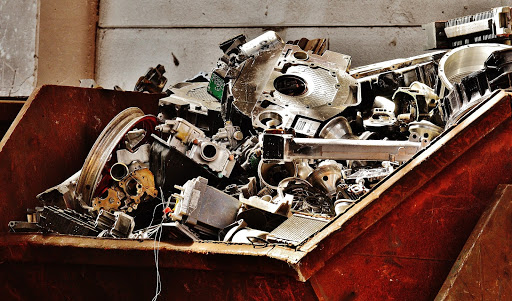
One of the strongest selling points for increasing recycling rates for scrap metals has been the proven environmental benefits.
Scrap metal recycling reduces air pollution. It’s that simple. Or is it?
Let’s get into the numbers.
It’s easy to make the case that scrap doesn’t belong in our landfills, where it can contaminate nearby soil and water supplies; instead, scrap belongs in a recycling plant where these metals can be made into new products and sold to manufacturers for reuse.
It’s also been a strong argument to point out that making products with recycled metals means manufacturers don’t have to rely on securing brand new metals by mining for virgin ore – a process that’s enormously taxing on our natural resources, from our land to our water and electricity.
Those arguments have been made in the past to encourage more consumers, businesses and municipal governments to boost recycling rates for everything that contains metals that are no longer being used.
But there’s another strong environmental argument to be made, and that’s the significant contribution that scrap metal recycling makes to something that a lot of us take for granted: air quality.
Scrap Metal Recycling Reduces Air Pollution? How so?
Recycling our scrap offers an increasingly long list of both environmental and economic benefits, which are being recognized on a global basis. That includes reducing our landfill use, utilizing a finite amount of natural resources, and reducing the cost of creating new products.
Metal recycling prevents habitats from being destroyed from mining new ore, and it stops the toxins contained in metals – like mercury and lead – from seeping out into landfill space as contaminated material. Recycling scrap offers health benefits to people and to the natural habitat of our wildlife. The list goes on.
For anyone who struggles with respiratory issues, recycling helps on another front: it reduces pollution. And while a lot of the environmental arguments in favor of scrap recycling have focused on keeping these metals out of landfills, the benefits to our air quality are just as significant.
So how does recycling influence air pollution? Think of it this way: the more scrap that consumers and businesses recycle, the less of it that ends up in landfills. According to a 2011 report by the University of North Carolina, that helps the air quality around those landfills.
Their study looked at the area around a landfill in Orange County, N.C., and concluded it had high levels of hydrogen sulfide gases. Their study was conducted after complaints from residents living around the landfill who had endured more respiratory problems and irritation of the eyes, nose and throat than people living farther away from it.
So we know that just as materials containing toxics can contaminate the soil and water close to landfills, we also understand they can emit gases that contribute to pollution. And recycling those metals instead eliminates that problem.
What else?
We also know that recycling improves air quality in another way, by cutting back on the need for heavy power usage. The Pennsylvania Department of Environmental Protection studied the impact that mining has on drilling for virgin ore and the subsequent refining, processing and shipping of those raw materials.
Their researchers concluded that the entire mining process requires a high amount of fossil fuels such as gasoline, diesel and coal to be burned. When that happens, there are pollutants that the industry ends up pumping into our atmosphere.
On the other hand, the collecting, processing and shipping of recycled materials to industrial users requires considerably less energy than mining does, Pennsylvania’s DEP noted.
The less power that we need in order to provide manufacturers with metals, and the less power we use up processing raw materials, the more we’re able to reduce greenhouse gas emissions. The entire process of creating new metals produces more greenhouse gas, emissions that can lead to hazardous levels of air pollution and cause respiratory health issues. Studies also indicate those emissions could be contributing to climate change.
Recycling is a much better alternative because there’s far less need to burn fossil fuels. We also know that recycling, unlike mining, doesn’t require us to knock down trees as part of the process – an important benefit since living trees help soak up carbon dioxide. This is called “increased forest carbon sequestration.”
Those are good examples of how recycling helps reduce pollution problems. The University of Central Oklahoma did a study which concluded that when manufacturers use recycled steel, it reduced 97 percent of the mining waste that comes through the processing of virgin ore as a resource. That helped to cut back 86 percent of air pollution and 76 percent on water pollution.
Recycling is particularly beneficial in the way this process conserves energy, since it requires significantly less energy to use recycled materials to manufacture products. For example, recycling aluminum uses 95% less energy than if the same products were made from raw materials.
Recycling also reduces greenhouse gas emissions in another way: by cutting down on transportation use, which can also contribute to air pollution. Recycling metal contributes to global warming solutions rather than creating new pollution problems.
And recycling scrap metal also reduces acid mine damage, a form of water pollution caused when flowing water is exposed to sulfates in areas that get mined for metals. The result is water in rivers and streams that’s more acidic and damages the aquatic ecosystem.
Is the Message About Recycling’s Benefits Getting Out?

While a growing number of Americans understand the reasons why we don’t want everything that’s disposable to end up in landfills and the negative consequences of doing that, there’s still a need for consumers to comprehend all the positive benefits of recycling – and there are quite a few.
The benefits to the air we breathe are well documented. Studies indicate that if we could double the amount of recycled aluminum being used today, more than a million tons of pollutants would be kept out of the atmosphere.
Perhaps a solution here is for advocates of recycling to spend more time educating consumers about the ways in which recycling helps reduce emissions of air and water pollutants. Manufacturing products using recycled materials produces less air and water pollution than using virgin materials, and the process has even been shown to result in a net reduction of ten major categories of air pollutants, according to a study by the U.S. Environmental Protection Agency. That includes:
- nitrogen oxide
- particulates
- and sulfur oxides.
The Institute of Scrap Recycling Industries has noted that using ferrous scrap – which contains metals such as cast iron, mild steel, and stainless steel – instead of virgin materials in the production of steel and iron reduces Carbon Dioxide (CO2) emissions by nearly 60 percent. ISRI also issued a report noting that recycling metal instead of mining for it cuts greenhouse gas emissions by up to 500 million tons.
The EPA also noted that about 1.67 metric tons of CO2 emissions are avoided for every ton of municipal solid waste that gets recycled.
The scrap metal recycling industry is a great example of an industry that pumps billions into the global economy, and also offers huge benefits to our environment while helping us achieve a greener and healthier life. The recycling industry is our proven way to:
- conserve natural resources
- reduce greenhouse gas emissions
- use less energy when manufacturing new products
- reduce reliance on making metal from virgin ore.
Recycling is also our way to positively influence climate change by preventing harmful levels of air pollution in cities, which can also help result in fewer respiratory health problems among us.
And there’s another concern: reducing the need to incinerate scrap.
What’s the Problem with Burning Scrap?
Just as problematic as tossing scrap into landfills is attempting to have it incinerated, which is a problem not only in some developing nations but also in some American cities as well that use incinerators.
Recycling scrap metal instead of burying or burning it reduces the noxious emissions that are released from incinerators and landfill sites.
In some cities like Portsmouth, Virginia, curbside recyclables are sometimes incinerated rather than recycled. Incineration is not a form of recycling in practice or intent.
And incinerators are known to contribute to air pollution.
Conclusion
Scrap recycling remains a fast-growing industry since manufacturers have come to rely on recycled scrap to reduce the cost of making new products. And we all benefit from a healthier environment when we keep waste scrap out of our landfills.
There’s also a strong message to be sent about how scrap metal recycling helps improve our air quality and reduce respiratory problems.
What we need now is to increase the rates by which individuals and businesses bring their scrap metal to recycling firms like GLE Scrap Metal.
As a premier scrap metal and electronic recycler, GLE Scrap Metal performs environmentally-friendly processing and recycling of all base and precious metals. Family owned and operated, the scrap metal you bring to GLE will be processed and supplied to global end-users to be transformed into new products.
Call GLE Scrap Metal today at 855-SCRAP-88 to request a quote.



